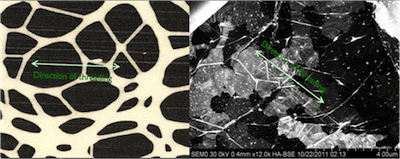
Those Nanodot readers who heard very interesting research results from Halcyon Molecular discussed at the Foresight Institute 25th Anniversary Reunion Conference (see here and here and these videos) will be interested in this update on the “Molecular Threading” portion of that technology found on KurzweilAI.net:
Teams of researchers from Harvard University and Halcyon Molecular, Inc. have disclosed “Molecular Threading,” the first technology to allow single DNA molecules to be drawn from solution and precisely manipulated, allowing for faster, cheaper, more accurate DNA sequencing.
This novel technology pulls single high-molecular weight DNA molecules from solution into air and then places them onto any surface. Halcyon Molecular developed the processes and the intellectual property is now owned by Palo Alto-based biotechnology firm Aeon Biowares.
“Molecular Threading offers a unique means of reaching from the macroscopic world into the world of large molecules with unprecedented exactitude,” says Dr. Chris Melville, CEO of Aeon Biowares and former Director of Chemistry at Halcyon Molecular. …
Additional details from the Aeon Biowares news release: “Molecular Threading, News of the First Public Disclosure“
Molecular Threading was invented by brothers Michael and William Andregg, the co-founders of Halcyon Molecular, Inc. Both co-authors on the current paper [open access: Molecular Threading: Mechanical Extraction, Stretching and Placement of DNA Molecules from a Liquid-Air Interface], the Andregg brothers were previously the subjects of a major profile in the national UK-based newspaper The Independent (“Silicon Valley: The anatomy of a cutting-edge start-up“, Sunday 14 August 2011).
The invention was spurred by the Andregg brothers’ quest for faster, cheaper, and more accurate DNA sequencing technologies. In particular, they needed a way to place DNA molecules onto surfaces in a more controlled manner than current techniques allow. As they tried many different techniques, including methods that are contrasted in the paper, they made an elegant discovery. A simple glass needle tip pulled from a Bunsen flame and coated with a hydrophobic polymer could stretch individual DNA molecules from water into air and place them onto a surface. Furthermore, due to the tension between the needle and the liquid, the DNA molecule is stretched in a geometrically predictable and reproducible way. The movie linked to here from the paper’s Supplementary Information shows how a bundle of DNA molecules remain normal to an air-water interface when stretched into air by the needle: DNA Thread Normal to Droplet Surface.
By attaching the needle to a piezo-positioner, they were soon able to make arrays of parallel stretched molecules as shown in the electron micrographs above. The image on the left shows DNA molecules threaded onto an electron microscopy grid with an amorphous carbon surface, while the image on the right shows DNA molecules threaded onto a graphene coated grid.
Molecular Threading is the enabling technology that allowed researchers for the first time to know the exact physical location of the DNA backbone. This together with the reproducible stretching meant that images that reveal the positions of the DNA bases could be used to determine the nucleotide sequence. This soon attracted the interest of Founders Fund partners Luke Nosek, Peter Thiel and Elon Musk, whose investments allowed the team to exploit Molecular Threading for DNA sequencing by electron microscopy.
Further characterization of the invention was performed by a collaboration of researchers working at Harvard University in the lab of George Church and by several researchers at Halcyon Molecular, some of whom are now working at Aeon Biowares. This includes Halcyon founding team member Kent Kemmish, now founder and CTO at Aeon Biowares.
“This is the first time anyone has ever pulled single high-molecule weight DNA molecules—or any macromolecules for that matter—out of solution and positioned them in a controlled way,” says Kemmish. “Though still in pre-commercial development, it is arguably one of the most advanced nanotechnologies in existence today.”
This advance is a very important nanotechnology that is especially important for DNA sequencing, and thus for personalized medicine, a major component of future medical technology. Much genomic DNA is riddled with many copies of repeated sequences. Current sequencing methods can only read a few hundred nucleotides at a time, so that determining the unique sequences flanking each copy of a repeated sequence can be very difficult. Precise manipulation of long DNA molecules opens the way to reading much longer sequences than can be done with current technology. The disclosure publication speculates “Applications beyond sequencing include nanofabrication, such as aperiodic templates for organic or inorganic materials using DNA as an organizing scaffold, or precision-patterned DNA nanowire arrays.” Organizing complex arrays of catalytic properties could be a step toward building complex molecular machine systems, perhaps as a step toward atomically precise manufacturing.
—James Lewis, PhD

